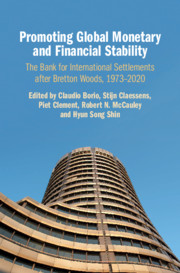 Promoting Global Monetary and Financial Stability
Promoting Global Monetary and Financial Stability Published online by Cambridge University Press: 10 April 2020
This chapter discusses the transformation of the Bank for International Settlements from a predominantly European organisation into a truly global one. This transformation coincided with, and was the result of, the rapid rise in prominence of the emerging-market economies, particularly from the 1990s. Until the mid-1990s the BIS, although serving the global central banking community, was in terms of governance and organisation strongly dominated by the Group of Ten advanced industrial countries. Because of history and statutory constraints – but also because the G10 very much valued their close cooperation – this changed only gradually. The chapter outlines in detail how and why the BIS first expanded its shareholding membership and only then its internal governance structure to become truly representative of the global economy. The great financial crisis of 2007–8 further accelerated this process, which was basically concluded by the end of the 2010s, with all major central banks being represented on the BIS Board of Directors.
To save this book to your Kindle, first ensure [email protected] is added to your Approved Personal Document E-mail List under your Personal Document Settings on the Manage Your Content and Devices page of your Amazon account. Then enter the ‘name’ part of your Kindle email address below. Find out more about saving to your Kindle.
Note you can select to save to either the @free.kindle.com or @kindle.com variations. ‘@free.kindle.com’ emails are free but can only be saved to your device when it is connected to wi-fi. ‘@kindle.com’ emails can be delivered even when you are not connected to wi-fi, but note that service fees apply.
Find out more about the Kindle Personal Document Service.
To save content items to your account, please confirm that you agree to abide by our usage policies. If this is the first time you use this feature, you will be asked to authorise Cambridge Core to connect with your account. Find out more about saving content to Dropbox.
To save content items to your account, please confirm that you agree to abide by our usage policies. If this is the first time you use this feature, you will be asked to authorise Cambridge Core to connect with your account. Find out more about saving content to Google Drive.